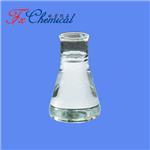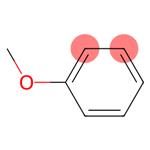- Anisole
-

- $0.00 / 1KG
-
2025-04-11
- CAS:100-66-3
- Min. Order: 1KG
- Purity: 98%min
- Supply Ability: 30tons/month
- Anisole
-

- $10.00 / 1KG
-
2025-03-31
- CAS:100-66-3
- Min. Order: 1KG
- Purity: 99%
- Supply Ability: 100 mt
- Anisole
-

- $0.00 / 200kg
-
2025-03-27
- CAS:100-66-3
- Min. Order: 20kg
- Purity: 99%
- Supply Ability: 20 tons
Related articles - What is Anisole used as?
- Anisole, also known as methoxybenzene (PhOMe), is a versatile organic aromatic ether compound. It is weakly polar, insoluble i....
- Dec 16,2024
- How to use anisole correctly
- Anisole is an organic compound with the chemical formula C7H8O with a pleasant anise-like aroma, used in organic synthesis and....
- Apr 13,2022
|
| | Anisole Chemical Properties |
| Melting point | -37 °C (lit.) | | Boiling point | 154 °C (lit.) | | density | 0.995 g/mL at 25 °C (lit.) | | vapor density | 3.7 (vs air) | | vapor pressure | 10 mm Hg ( 42.2 °C) | | refractive index | n20/D 1.516(lit.) | | FEMA | 2097 | ANISOLE | | Fp | 125 °F | | storage temp. | Store below +30°C. | | solubility | 1.71g/l | | form | Liquid | | color | Clear colorless | | Relative polarity | 0.198 | | Odor | phenol, anise odor | | Odor Type | phenolic | | biological source | synthetic | | explosive limit | 0.34-6.3%(V) | | Odor Threshold | 0.057ppm | | Water Solubility | 1.6 g/L (20 ºC) | | Merck | 14,669 | | JECFA Number | 1241 | | BRN | 506892 | | Dielectric constant | 4.3(20℃) | | Stability: | Stable. Flammable. Incompatible with strong oxidizing agents. | | InChIKey | RDOXTESZEPMUJZ-UHFFFAOYSA-N | | LogP | 2.62 at 30℃ | | CAS DataBase Reference | 100-66-3(CAS DataBase Reference) | | NIST Chemistry Reference | Benzene, methoxy-(100-66-3) | | EPA Substance Registry System | Anisole (100-66-3) |
| | Anisole Usage And Synthesis |
| Product Features | Anisole, also known as anise ether, methoxybenzene methyl phenyl ether, is a colorless liquid with an odor of anise, sweet, naturally present in the tarragon oil, insoluble in water, soluble in alcohol, ether, acetone, soluble in benzene. It irritates the eyes and mucous membranes. It is obtained originally from distilled methyl salicylate or methoxybenzoate, is now mainly produced through the reaction of methylating agent of dimethyl sulfate with phenol in alkaline aqueous solution. Anisole is prone to start Electrophilic substitution reaction in aromatic nucleus, and condensed with formaldehyde to produce viscous oil or resin material, reacts with phosphorus trichloride to produce chlorine anisole and a small amount of o-chloro product, reacts with thionyl chloride to produce 2,4,6-trichloroanisole. In addition, anisole is heated to react with hydrobromic or hydroiodic, carbon-oxygen bond cleaves, phenol and halogenated methane is produced, which is an important method for determining methoxy group of benzene ring.
The above information is edited by the chemicalbook of Yan Yanyong.
| | Uses | 1. Anisole is a solvent used in the synthesis of organic compounds and in large-scale applications such as the production of perfumes.
2. GB2760-1996 stipulates it as allowable usable spices in food. It is mainly used for the preparation of vanilla, fennel and beer flavor.
3. It is used for analyzing the reagents, solvents, and used for preparing perfumery and enteral pesticides.
4. Anisole has been used directly in the synthesis of the marine pyrrole alkaloids polycitone A and B and the nonylphenol isomer 4-(3',6'-dimethyl-3-heptyl)phenol.
5. It is used as solvents for recrystallization, fillers of thermostat, and used for measuring refractive index, as spices and organic synthesis intermediates. | | Toxicity | Anisole has acute toxicity, LD50: 3700mg/kg (oral in rats); 2800mg/kg (oral in mice). Rabbit percutaneous: 500mg (24h), moderate stimulation. Anisole is also mutagenic, causing DNA inhibition, 25 μmol/L in human lymphocytes. | | Production method | Anisole is produced through the reaction of methylating agent of dimethyl sulfate with phenol in alkaline aqueous solution. Phenol was mixed with sodium hydroxide solution, dimethyl sulfate was slowly added at below 10°C. And then heat to 40 °C, reflux for 18h, then stand for separation of the oil and dried with anhydrous calcium chloride, vacuum distillation to obtain anisole.
It is derived by introducing the methyl chloride into the sodium phenol of liquid ammonia to react.
It is generated from heating phenol and methanol.
It is obtained from the reaction of phenol with dimethyl sulfate in the presence of sodium hydroxide. | | Limited use | FEMA (mg/kg): Soft drinks 9.0, cold 16, confectionery51, bakery 34.
limited in moderation (FDA§172.515,2000). | | Description | Anisole is a colorless liquid with a spicy-sweet smell. Anisole can be produced by all the aforementioned methods. It is an important intermediate in the synthesis of organic compounds, for example fragrances and pharmaceuticals. The compound is also used as a solvent and as a heat transfer medium. | | Chemical Properties | Anisole is a colorless to yellowish liquid with a characteristic pleasant, anise-like, agreeable, aromatic, spicy-sweet odor. It is used in perfumery. | | Occurrence | Anisole is a natural product found in apple juice and in the oil of Artemisia dracunculus var. turkestanica; also reported found in butter, Camembert cheese, roasted beef, olive (Olea europae), Malay apple, Jerusalem artichoke (Helianthus tuberosus), Bourbon vanilla, truffles, crab and sopadilla fruit (Achras sapota L.). | | Uses | Anisole is widely used as a solvent for the synthesis of various organic compounds, anethole, nonylphenol isomer 4-(3',6'-dimethyl-3-heptyl)phenol, perfumes, insect pheromones and pharmaceuticals. It finds application in the preparation of inorganic complexes and materials such as tin-core/tin oxide nanoparticles. | | Definition | ChEBI: Anisole is a monomethoxybenzene that is benzene substituted by a methoxy group. It has a role as a plant metabolite. | | Application | Anisole is an organic compound with the chemical formula C7H8O with a pleasant anise-like aroma, used in organic synthesis and also as a solvent, fragrance and insect repellent. For organic synthesis, it is also used as solvent, fragrance and insect repellent. | | Preparation | Anisole is synthesized by reacting phenol and dimethyl sulfate in the presence of aqueous NaOH; by passing methyl chloride into a suspension of sodium phenolate in liquid ammonia. | | Aroma threshold values | Detection: 50 ppb | | Synthesis Reference(s) | Canadian Journal of Chemistry, 40, p. 441, 1962 DOI: 10.1139/v62-070
Journal of the American Chemical Society, 88, p. 4271, 1966 DOI: 10.1021/ja00970a037
Organic Syntheses, Coll. Vol. 1, p. 58, 1941 | | General Description | A clear straw-colored liquid with an aromatic odor. Insoluble in water and the same density as water. Vapors heavier than air. Flash point 125°F. Boiling point 307°F. Moderately toxic by ingestion. A skin irritant. Used to make perfumes, flavorings and as a solvent. | | Air & Water Reactions | Flammable. Ethers tend to form unstable peroxides when exposed to oxygen. Ethyl, isobutyl, ethyl tert-butyl, and ethyl tert-pentyl ether are particularly hazardous in this respect. Ether peroxides can sometimes be observed as clear crystals deposited on containers or along the surface of the liquid. Insoluble in water | | Reactivity Profile | Ethers, such as Anisole can act as bases. They form salts with strong acids and addition complexes with Lewis acids. The complex between diethyl ether and boron trifluoride is an example. Ethers may react violently with strong oxidizing agents. In other reactions, which typically involve the breaking of the carbon-oxygen bond, ethers are relatively inert. | | Health Hazard | Inhalation or contact with material may irritate or burn skin and eyes. Fire may produce irritating, corrosive and/or toxic gases. Vapors may cause dizziness or suffocation. Runoff from fire control or dilution water may cause pollution. | | Safety Profile | Moderately toxic by
ingestion and inhalation. A skin irritant. A
flammable liquid. To fight fire, use foam,
CO2, dry chemical. When heated to
decomposition it emits acrid fumes. | | Potential Exposure | Anisole is used as a solvent; a flavoring,
vermicide, making perfumes; and in organic synthesis. | | First aid | If this chemical gets into the eyes, remove anycontact lenses at once and irrigate immediately for at least15 min, occasionally lifting upper and lower lids. Seek medical attention immediately. If this chemical contacts theskin, remove contaminated clothing and wash immediatelywith soap and water. Seek medical attention immediately. Ifthis chemical has been inhaled, remove from exposure,begin rescue breathing (using universal precautions, including resuscitation mask) if breathing has stopped and CPR ifheart action has stopped. Transfer promptly to a medicalfacility. When this chemical has been swallowed, get medical attention. Give large quantities of water and inducevomiting. Do not make an unconscious person vomit. | | storage | Color Code—Red: Flammability Hazard: Store ina flammable liquid storage area or approved cabinet away from ignition sources and corrosive and reactive materials.Prior to working with this chemical you should be trainedon its proper handling and storage. Before enteringconfined space where anisole may be present, check tomake sure that an explosive concentration does not exist.Store in tightly closed containers in a cool, well-ventilated,fireproof area. Metal containers involving the transfer ofthis chemical should be grounded and bonded. Wherepossible, automatically pump liquid from drums or otherstorage containers to process containers. Drums must beequipped with self-closing valves, pressure vacuum bungs,and flame arresters. Use only nonsparking tools and equipment, especially when opening and closing containers ofthis chemical. Sources of ignition, such as smoking andopen flames, are prohibited where this chemical is used,handled, or stored in a manner that could create a potentialfire or explosion hazard. | | Shipping | Anisole requires a shipping label of“FLAMMABLE LIQUID.” Anisole falls in Hazard Class 3,Packing Group III.[19, 20] | | Purification Methods | Shake anisole with half its volume of 2M NaOH, and the emulsion is allowed to separate. Repeat three times, then wash twice with water, dry over CaCl2, filter, dry over sodium wire and finally distil it from fresh sodium under N2 using a Dean-Stark trap (samples in the trap being rejected until free from turbidity) [Caldin et al. J Chem Soc, Faraday Trans 1 72 1856 1976]. Alternatively dry it with CaSO4 or CaCl2, or by refluxing with sodium or BaO with crystalline FeSO4 or by passage through an alumina column. Traces of phenols are removed by prior shaking with 2M NaOH, followed by washing with water. It has been be purified by zone refining. [Beilstein 6 IV 548.] | | Incompatibilities | Incompatible with oxidizers (chlorates,
nitrates, peroxides, permanganates, perchlorates, chlorine,
bromine, fluorine, etc.); contact may cause fires or explosions. Keep away from alkaline materials, strong
bases, strong acids, oxoacids, epoxides. | | Waste Disposal | Dissolve or mix the material
with a combustible solvent and burn in a chemical incinerator
equipped with an afterburner and scrubber. All federal,
state, and local environmental regulations must be
observed. |
| | Anisole Preparation Products And Raw materials |
| Raw materials | Sodium hydroxide-->Dimethyl sulfate-->Phenol-->Dimethyl ether | | Preparation Products | 1-Methyl-1H-imidazole-4-carboxylic acid-->Imidazole-4-methanol-->4,5-Imidazoledicarboxylic acid-->1-METHYL-1H-IMIDAZOLE-5-CARBOXYLIC ACID-->Cefdinir-->1,5-Diazabicyclo[4.3.0]non-5-ene-->4,5-DICARBOXY-1-METHYL-1H-IMIDAZOLE-->ALLURA RED AC-->Diaveridine-->Ceftibuten-->PYRIDIN-4-YLMETHYL-HYDRAZINE-->PYRIDIN-2-YLMETHYL-HYDRAZINE-->1H-Imidazole-4-carboxylic acid-->Methyldopa-->1-METHYL-1H-IMIDAZOLE-4,5-DICARBONITRILE-->PYRIDIN-3-YLMETHYL-HYDRAZINE-->Lawesson's Reagent-->6-Hydroxy-1-naphthoic acid-->Disperse Blue BGL-->Bunazosin hydrochloride-->CHLOROTRIANISENE-->cleaner LS-->Cefcapene pivoxil-->Verapamil-->6-METHOXY-1-NAPHTHOIC ACID-->Anoxomer-->Alacepril-->trisodium [5-acetamido-4-hydroxy-3-[[2-hydroxy-5-[[2-(sulphooxy)ethyl]sulphonyl]phenyl]azo]naphthalene-2,7-disulphonato(5-)]cuprate(3-)-->2-Bromoanisole-->3-(4-METHOXYBENZOYL)PROPIONIC ACID-->4,5-Dicyanoimidazole-->4-Chloro-4'-hydroxybenzophenone-->4-chloro-4'-methoxybenzophenone-->1-CHLOROMETHYL-2,3,4-TRIMETHOXYBENZENE-->METHOXYCHLOR-->Anisyl acetate-->Fast Scarlet Base LG-->2,4,6-TRIBROMOANISOLE-->Fenofibrate-->4-Fluoro-4'-methoxybenzophenone |
|